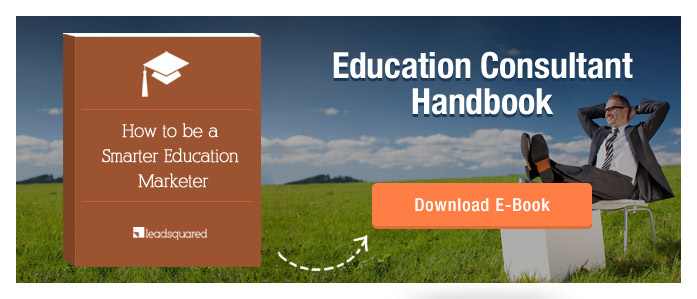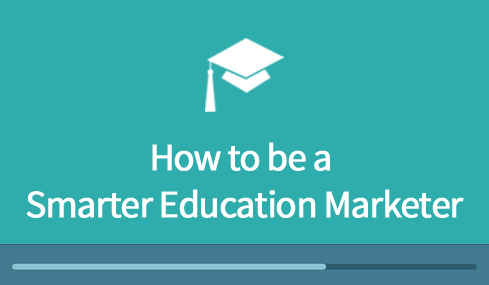A wide range of questions were asked at the webinar on ‘How to be a Smarter Education Marketer’ conducted by Nilesh Patel, CEO of LeadSquared. Those of you who missed the webinar, here’s a summary of some of the questions asked during that session. You could also listen to the webinar recording on ‘How to be a Smarter Education Marketer’ here.
Webinar FAQs:
Question 1
What do you think is the best way of promoting online educational services? Is it Facebook ads, AdWords, paid webinars or anything else?
I think you need to try all the education marketing options available to you, one by one. Each of them has a cost to it. It takes a certain bandwidth to do all of that. Let me give you an example. We started doing webinars a long ago. We also did some ground events in Bangalore. We didn’t generate a lot of interest from our ground events. They were not turning into sales for us so we stopped that. Similarly, the important thing here is to measure whatever you are trying so that you are able to conclude if a particular promotional activity is actually helping you drive sales or positive interest.
Question 2
I want to conduct an overseas education survey, but as we know, nobody wants to fill the survey form easily. What can be done to get genuine survey answers from students?
A good way to get answers from surveys is to give them something (some piece of information) in exchange for their response. Now that has to be tangible. Since you said, they are not genuine survey answers, a good way to start would be to potentially think of starting a telephonic survey. Here’s what you need to do.
Let’s say you have a season that starts in August. You can spend some money, like Rs 5000 – 20000 in collecting leads from overseas education consultants and then do a telephonic survey with those leads. While speaking to those leads, you tell them that if they answer 5 questions from your survey, you will send them some offers. This may be a free counselling session or anything else that is relevant and of value to them. You could also ask your counsellor to send them an email with the survey (presuming that the student would be willing to listen to the counsellor since he/she has already connected with the counsellor).
Question 3
When to decide that the lead has become obsolete and should now be left on its own?
I’m a sales person so I won’t give up until the lead says no. But I think, given the lead volume you have, and if you have fresh leads coming in, you may decide to ignore a lead because it doesn’t fit your ideal customer profile or the profile of the client you want to serve. So what is the ideal customer profile for an overseas education business? Here are a couple of factors that could help you identify that:
- The student must have the finances required to study abroad
- The student must have sufficient grades or marks to qualify for that college/university
When you evaluate all of these factors, you will be able to figure out if they fit or don’t fit the customer profile. If they don’t fit one or more factors, then you obviously don’t follow up with them. On the other hand, if they fit, but are already tied up with a consultant, then continue to connect with them and see if there is an option/opportunity to pull them back. However, if the lead becomes unresponsive, even after months of trying, you can ignore it.
Question 4
How about understanding external factors affecting leads? Factors like, other colleges are better than the ones we represent (i.e. competition).
There are wide choices of colleges and there are enough students to fill those choices. Let’s say, if you are only representing certain types of colleges out there, in that case, you have to position only them. There could be other consultants having different colleges or better courses and programs. However, you have to highlight what is good from what you are offering and how it can help the career of the student. I’d suggest you try these things.
If the location of where your college is situated has a tourism appeal or a travel appeal, you can use that to your advantage. That’s something a business would find out as it evolves. It’s about the product that you are offering which is bound to attract a type of student. So, you have to basically get better at identifying those students.
Question 5
What to do when there is a lead who is impatient to listen to all the information?
If the customer doesn’t want to listen to you, then you should listen to them. Hear them out and see if they really want to take your advice. If they don’t want to take your advice, I suggest you move on to the next student.
Question 6
In the education industry, what first hand information should be given to a prospective student?
You see, in the education industry, students go abroad or take a particular course to do something with their lives. First and foremost, you need to make sure that the students know about the services of your business, even before they become a lead. Students would ideally look at your business in terms of how you have helped other students. Testimonials are a great way to get this going. After that, once they come in, you should help them identify what courses or programs will help them in their career. As a counsellor, I would help them identify what choices are available to them which will make a better career for them or open bigger opportunities.
Question 7
Please throw light on costing between inbound and outbound marketing in education business.
Both of them have their own costs. When you say outbound, I’m presuming you mean leads coming in, and then you call them. In that case, you obviously have to decide if your business can afford to do an outbound call for every lead coming in. If your ticket size is small, meaning you make a few thousand rupees from a particular lead, outbound calls don’t really make sense from a business standpoint.
As far as inbound goes, it has multiple channels. This includes, content strategy, paid ads, organic strategy, and so on. You would need to do a mix of all of that to figure out and then proportionally push the lead and allocate the budget. In inbound, the biggest cost would be writing a blog (if it is content strategy). If you write high quality or good content, which is going to be picked up by Google and others, it is going to drive traffic.
Plus, you need people who can turn that content around into a PPT or PDF or a video format and re-purpose that for lead generation. For example, if you have good content in your blog, pick that up and make a SlideShare presentation.
Question 8
What could be the best mode of advertisement to cater to the niche target audience, especially for creating awareness about an emerging profession?
It’s almost like you are introducing a new product or a new concept which people are not aware of. The way to go about doing that is associating that product with a branded product in that category. For example, if you are competing against product A and positioning a new product B, you could write a post about why B is better than A, what are the differences between A and B, and so on. Then, somebody who is searching for A will basically find B.
You could also run ads. In this case, you can run ads on the keywords of A but show B. When they land on your landing page, you basically explain the product. Talk about why B is better than A, using a video or a documentary.
Question 9
If my company provides online as well as offline courses, how do I decide which course to roll out for free, and which one to charge? Also, suggest ways to determine the amount to be charged for a course.
Ideally, when you offer something for free, you would want to collect leads so you can sell them a paid course in future. Hence, the free offer should be of value in the eyes of the visitor, so that they are willing to exchange their information. If they get some value out of that free stuff, there is a high likelihood that you will get them enrolled onto your paid program as well. It’s like a trailer of a movie. The trailer encourages the visitor to see the movie.
Coming to how much you should charge for the course – I think in the online world, if you are selling something (a course in this case), there are multiple ways to do that. You can do price A/B testing. Initially, you could price it for 10,000. A couple of days later, you could price it at 15,000. Over a period of time, you change the pricing. If you find that the demand hasn’t gone down, then there is a price elasticity in the market. This means that you can charge more for the same course and demand is stable. Thus, if you are able to increase the price and the demand remains the same, then maybe there are people out there who can pay more so you can go further.
Question 10
According to you investing in third-party data for education leads is not a good idea right? Kindly elaborate and justify.
If you are referring to buying third-party data, (and this is my personal experience and I have heard this from other customers as well), 50% of the data coming in is junk. People just sell the same data again and again to a hundred people and that data is of no good value. In fact, I have seen the data myself. One of my customers bought data and I looked at it. It had XXX rated words in the email addresses. That comprised more that 10% of the data. The poor quality words in those email addresses reflect the poor quality of data, and the buyer ends up paying for junk leads.
If you have such data, there is a free service which LeadSquared offers, called EmailValidator. If you are buying emails from various sources, it allows you to validate those email addresses. You can validate each one any number of times and also validate up to 500 email records at a time. Contact us if you need that free service.










